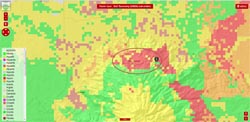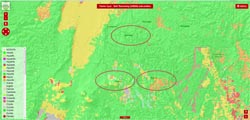Common bean (Phaseolus vulgaris L.) is one of the most important grain legumes in Uganda. It forms an important part of the traditional diet and provides a good source of income for the rural communities. Experiments with rhizobial inoculation on beans in East Africa have met with varying success. One possible explanation is that common bean can establish effective symbiosis with broad range of native rhizobia. The role of this so-called promiscuity in the irregular response to inoculation remains to be established. It is currently not known how the composition of the rhizobial population in soil affects nitrogen fixation in common bean.
|
In my PhD project, I will explore the abundance and diversity of rhizobia and determine inoculation response of common bean in different soils and the effects of environmental and cropping practices. From the study, effective and competitive indigenous rhizobium strains will be identified and will be assessed for their potential as commercial inoculants with the aim of increased and sustainable bean production within the region. At the start, rhizobia will be isolated from 80 soil samples within the common bean (climbing bean variety) growing areas in the South-Western and Eastern highlands in Uganda where N2Africa is actively working with smallholder farmers. My current focus is using ISRIC maps to characterize the different soil types in the bean growing areas and to identify the land use practices in relation to the cropping history. This data will be used to select sample soils for physico-chemical analysis, most-probable numbers (MPNs) and rhizobial trapping. Allan Ochieng, Wageningen University, The Netherlands |
|


 Figure 1: ISRIC soil maps for Kapchorwa (top), Kanungu, Kabale and Kisoro (bottom) at a scale of 1:10km
Figure 1: ISRIC soil maps for Kapchorwa (top), Kanungu, Kabale and Kisoro (bottom) at a scale of 1:10km